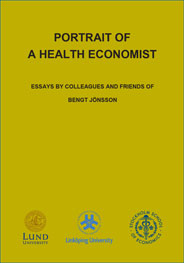Sign up to our newsletter Subscribe
Analysing Global Immunisation Expenditure

Sign up to our newsletter Subscribe


Launched at a seminar in his honour May 2014, Portrait of a Health Economist: Essays by Colleagues and Friends of Bengt Jönsson is an impressive collection of essays commemorating Bengt’s lifetime contribution to health economics. He was one of the…

Launched at a seminar in his honour May 2014, Portrait of a Health Economist: Essays by Colleagues and Friends of Bengt Jönsson is an impressive collection of essays commemorating Bengt’s lifetime contribution to health economics. He was one of the true pioneers in the field – his 1976 doctoral thesis was on cost-benefit analysis in public health and medical care. He has since published hundreds of papers, reports and book chapters worldwide.
Launched at a seminar in his honour May 2014, Portrait of a Health Economist: Essays by Colleagues and Friends of Bengt Jönsson is an impressive collection of essays commemorating Bengt’s lifetime contribution to health economics. He was one of the true pioneers in the field – his 1976 doctoral thesis was on cost-benefit analysis in public health and medical care. He has since published hundreds of papers, reports and book chapters worldwide. In 1979, Bengt founded the Swedish Institute for Health Economics (IHE), using the OHE as a model, and in 1982 became professor of health economics at the University of Linköping, where he founded the Center for Medical Technology (CMT). IHE and CMT today are the focal institutions for health economics in Sweden. In 1991, Bengt moved to the Stockholm School of Economics, where he is now Professor Emeritus and remains as active as ever. He joined the OHE Policy Board[1] in 2007.
Edited by Tony Culyer and Gisela Kobelt, the book’s list of contributors reads like a worldwide who’s who of experts in the field, including OHE Policy and Editorial Board members Martin Buxton, Tony Culyer, Mike Drummond, and Peter Zweifel, as well as past OHE Annual Lecturers Bob Evans, Uwe Reinhardt and Milt Weinstein. The thirty chapters address a range of topics including: health economics and politics; the theory underlying the design of health economic evaluation and its use in decision making; specific analytical techniques and approaches, e.g. QALYs; appropriate use of cost effectiveness analyses in health care decision making in general, in specific countries or to meet specific goals such as designing a benefits package; the health economics of particular diseases, e.g. diabetes and cancer; and chapters specifically on aspects of Bengt’s contributions to the field.
The chapter contributed by OHE’s Adrian Towse[2] discusses Bengt’s observations in a 2011 publication[3] about the role of relative effectiveness research (RE) in the European medicines market. To ensure value for money, understanding actual use of medicines in the health care system is an essential supplement to information from clinical trials. To move in this direction, Towse defines a deceptively simple challenge: creating an environment where choice of therapy is based on an optimal amount of evidence from relative effectiveness research that is generated and used efficiently across health care systems. He identifies three sets of changes that must occur to meet the challenge:
Towse notes that ‘appraisal of RE evidence should edge both parties towards efficient pricing and use of a new drug’, (p. 185), which he believes EU reforms can encourage in various ways. He is somewhat less optimistic about trans-Atlantic convergence.
[1] OHE’s Policy Board provides advice and guidance on OHE’s research programmes. A full list of current Policy and Editorial Board members is available here on our website.
[2] Towse, A., 2014. Comparative and relative effectiveness: a challenge for health systems, regulators, or the pharmaceutical industry? In Culyer, A.J. and Kobelt, G. eds. Portrait of a health economist: essays by colleagues and friends of Bengt Jönsson. Lund: Swedish Institute for Health Economics, pp.179-188.
[3] Jönsson, B., 2011. Relative effectiveness and the European pharmaceutical market. European Journal of Health Economics. 12(2), pp.97-102.
The book may be downloaded as a pdf from the website of the Swedish Institute of Health Economics.
An error has occurred, please try again later.
This website uses cookies so that we can provide you with the best user experience possible. Cookie information is stored in your browser and performs functions such as recognising you when you return to our website and helping our team to understand which sections of the website you find most interesting and useful.
Strictly Necessary Cookie should be enabled at all times so that we can save your preferences for cookie settings.
If you disable this cookie, we will not be able to save your preferences. This means that every time you visit this website you will need to enable or disable cookies again.
This website uses Google Analytics to collect anonymous information such as the number of visitors to the site, and the most popular pages.
Keeping this cookie enabled helps us to improve our website.
Please enable Strictly Necessary Cookies first so that we can save your preferences!


